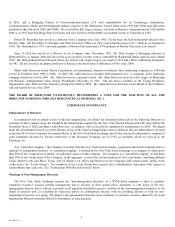CompUSA 2008 Annual Report Download - page 20
Download and view the complete annual report
Please find page 20 of the 2008 CompUSA annual report below. You can navigate through the pages in the report by either clicking on the pages listed below, or by using the keyword search tool below to find specific information within the annual report.11
KL2 2600873.8
EXECUTIVE COMPENSATION
Compensation Discussion and Analysis
In this section, we discuss the material elements of our compensation programs and policies, including the objectives of our
compensation programs and the reasons why we pay each element of our executives’ compensation. Following this discussion, you
will find a series of tables containing more specific details about the compensation earned by, or awarded to, the following individuals,
whom we refer to as the Named Executive Officers or NEOs. This discussion focuses on compensation practices relating to the Named
Executive Officers for our 2008 fiscal year.
Our Named Executive Officers in 2008 (based on total 2008 compensation earned) were as follows:
Richard Leeds Chairman; Chief Executive Officer
Bruce Leeds Vice Chairman
Robert Leeds Vice Chairman
Gilbert Fiorentino Chief Executive - Technology Products Group
Lawrence Reinhold Executive Vice President; Chief Financial Officer
Objectives and Philosophy of Our Executive Compensation Programs
The Company’ s executive compensation programs are designed to achieve a number of important objectives, including attracting
and retaining individuals of superior ability and managerial talent, rewarding individual contributions to the achievement of the
Company’ s short and long-term financial and business objectives, promoting integrity and good corporate governance, and motivating
executive officers to manage the Company in a manner that will enhance the Company’ s growth and financial performance for the
benefit of our stockholders, customers and employees.
Compensation of the Company’ s named executive officers is based primarily upon an evaluation of Company performance as it
relates to three general business areas:
Operational and Financial Performance (utilizing standard metrics such as net sales, operating income, consolidated
net income,
earnings before interest and taxes (“EBIT”), gross margin, operating margin, earnings per share, working
capital, return on invested capital, stockholder equity and peer group comparisons);
Strategic Accomplishments (including growth in the business, i
mplementation of systems, process and technology
improvements, and growth in the value of the Company’ s assets, including through strategic acquisition
transactions); and
Corporate Governance and Oversight (encompassing legal and regulatory compliance
and adherence to Company
policies including the timely filing of periodic reports with the SEC, the Sarbanes-
Oxley Act, environmental,
employment and safety laws and regulations and the Company’ s corporate ethics policy).
Accordingly, in determining the amount and mix of compensation, the Compensation Committee seeks both to provide a
competitive compensation package and to structure annual and long-term incentive programs that reward achievement of performance
goals that directly correlate to the enhancement of sustained, long-term shareholder value, as well as to promote executive retention.
To accomplish these objectives, the Committee has structured our compensation programs to reward achievement in the foregoing
areas.
In determining the compensation of a particular executive, consideration is given to the specific corporate responsibilities that such
executive is charged with as they relate to the foregoing business areas.
Elements of Our Executive Compensation Programs
To promote the objectives described above, our executive compensation programs consist of the following principal elements:
























